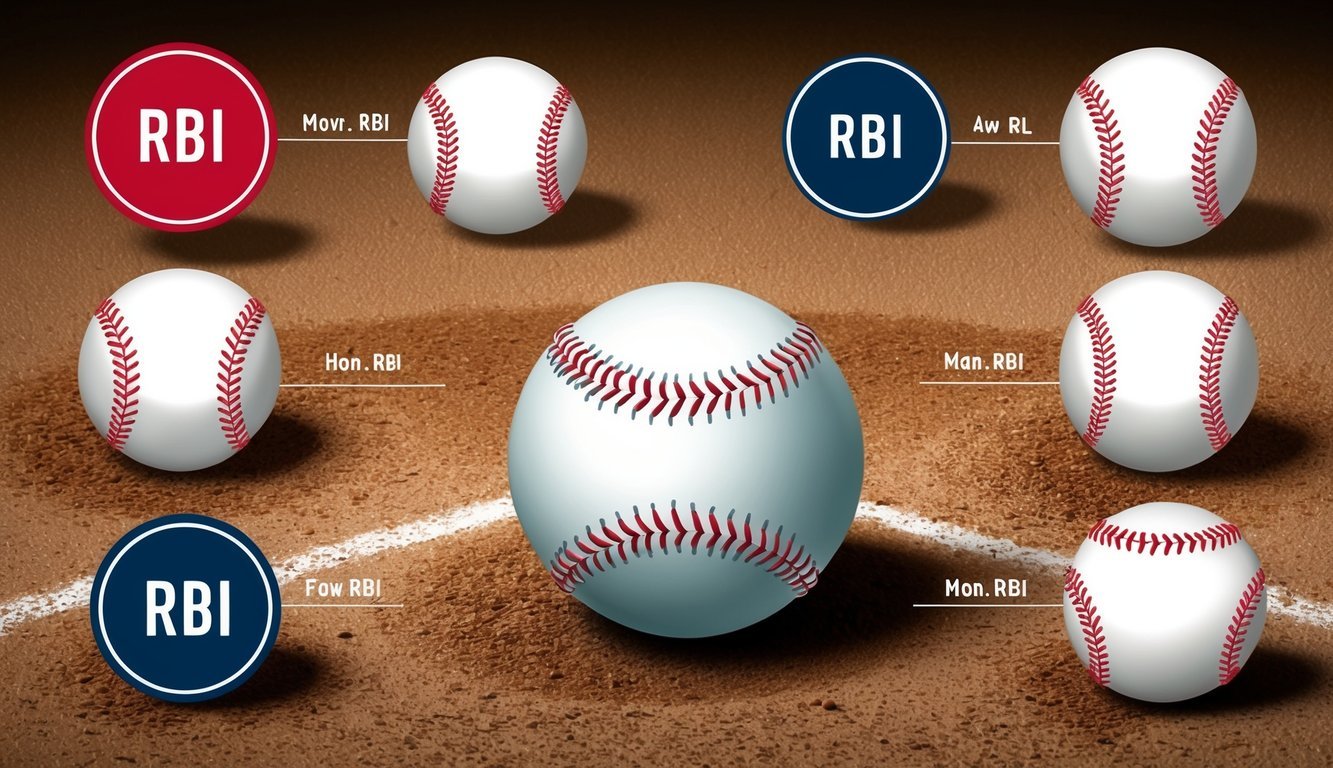In baseball, RBI stands for “Runs Batted In.” This crucial statistic measures a player’s ability to drive in runs and contribute to their team’s score. A batter earns an RBI when their action at the plate directly results in a run crossing home plate.
RBIs can be earned through various means.
A player receives an RBI for hits that allow baserunners to score, including singles, doubles, triples, and home runs.
Even certain outs can result in an RBI if a run scores on the play.
Interestingly, a batter can also be credited with an RBI for drawing a walk or being hit by a pitch with the bases loaded, forcing in a run.
The RBI statistic holds significant value in evaluating a player’s offensive impact.
It forms part of baseball’s prestigious Triple Crown, alongside home runs and batting average. While individual RBI totals can fluctuate based on factors like batting order position and teammates’ on-base skills, consistently high RBI numbers often indicate a player’s knack for delivering in clutch situations.
Explaining the Basics of RBI
RBI is a crucial statistic in baseball that measures a player’s ability to drive in runs.
It reflects how well a batter helps their team score and win games.
Definition of RBI
RBI stands for “Runs Batted In.” It’s a statistic that counts the number of runs a batter is responsible for scoring.
When a batter’s actions result in a run crossing home plate, they receive credit for an RBI.
This stat helps measure a player’s offensive contribution to their team.
RBIs are especially valued for players in the middle of the batting order, who often have more opportunities to drive in runs.
How RBI Is Scored
A batter earns an RBI in several ways:
- Hitting a single, double, or triple that allows a runner to score
- Hitting a home run (the batter gets an RBI for themselves and any runners on base)
- Drawing a walk or getting hit by a pitch with the bases loaded
- Hitting a sacrifice fly that allows a runner to tag up and score
- Grounding out or reaching base on an error, allowing a run to score
RBIs are not awarded for runs that score due to errors, double plays, or stolen bases.
The Role of the Batter
The batter plays a crucial role in earning RBIs.
Their primary job is to advance runners and help them score.
Successful RBI hitters often have:
- Good batting average with runners in scoring position
- Power to hit extra-base hits and home runs
- Ability to make contact and put the ball in play
- Patience to draw walks when needed
Teams rely on their best RBI producers to drive in runs in key situations.
These players are often placed in the lineup where they have the most opportunities to bat with runners on base.
The Importance of RBI in Baseball
RBIs play a crucial role in measuring a player’s offensive impact and contribution to their team’s success.
This statistic highlights a batter’s ability to drive in runs and influence the outcome of games.
RBI as a Measure of Success
RBI (Runs Batted In) serves as a key indicator of a player’s offensive productivity.
It reflects a batter’s skill in bringing runners home and directly contributing to the team’s score.
Players with high RBI totals are often seen as valuable assets to their teams.
RBIs are particularly prized in clutch situations, such as when runners are in scoring position.
A player’s ability to consistently drive in runs can make them a formidable threat at the plate.
This statistic is also part of baseball’s offensive Triple Crown, alongside home runs and batting average.
Hank Aaron and Hack Wilson’s historic RBI achievements showcase the potential impact of this statistic on a player’s legacy.
RBI and Team Strategy
Teams often structure their lineups to maximize RBI opportunities.
Managers typically place their best RBI producers in the middle of the batting order, where they’re more likely to come up with runners on base.
RBIs influence game strategy, as teams may sacrifice outs to move runners into scoring position.
This creates RBI chances for subsequent batters.
The stat also affects player evaluation and roster construction decisions.
High-RBI players can change the complexion of a game with a single swing.
Their presence in the lineup puts pressure on opposing pitchers and influences defensive positioning.
Famous RBI Records in MLB History

Runs batted in (RBI) showcase a player’s ability to drive in runs and contribute to their team’s success.
Over the years, MLB has seen remarkable RBI performances that have left lasting impressions on the sport.
All-Time RBI Leaders
Hank Aaron tops the career RBI list with an astounding 2,297 runs driven in.
His consistency and power at the plate made him a feared hitter for over two decades.
Albert Pujols finished his career in second place with 2,218 RBIs.
His incredible production spanned multiple teams and eras.
Babe Ruth, often considered the greatest player ever, sits third with 2,214 RBIs.
His ability to hit for power and average made him a run-producing machine.
Alex Rodriguez (2,086 RBIs) and Cap Anson (2,075 RBIs) round out the top five.
Their long careers and consistent offensive output earned them spots among baseball’s elite.
Memorable RBI Moments
Hack Wilson’s 1930 season stands as the gold standard for single-season RBI production.
He drove in an incredible 191 runs, a record that has stood for over 90 years.
Lou Gehrig’s 1931 campaign saw him rack up 185 RBIs, the second-highest single-season total.
The Iron Horse’s ability to hit with runners on base was unparalleled.
In more recent history, Sammy Sosa’s 160 RBIs in 2001 showcased the offensive explosion of the era.
His powerful swing and lineup protection led to numerous run-scoring opportunities.
Mark McGwire’s 147 RBIs in just 155 games during the 1998 season highlighted his incredible efficiency.
Nearly every at-bat seemed to result in a run-scoring opportunity.
Understanding RBI-Related Statistics

RBI is a key offensive statistic in baseball, but it’s closely tied to several other metrics.
These stats provide a more complete picture of a batter’s performance and impact on the game.
RBI in Relation to Other Batting Metrics
Batting Average (BA) measures how often a player gets hits, while RBI focuses on run production.
A high BA doesn’t always mean high RBI totals.
On-base Percentage (OBP) includes walks and hit-by-pitches, which can lead to RBIs if runners are on base.
Slugging Percentage (SLG) reflects extra-base hits, often resulting in multiple RBIs.
OPS combines OBP and SLG, giving a broader view of a player’s offensive contributions.
Players with high OPS tend to have more RBI opportunities.
Limitations and Criticisms of RBI Stat
RBI totals depend heavily on factors outside a batter’s control, like teammates’ ability to get on base.
A great hitter on a weak team might have fewer RBIs than expected.
The stat doesn’t account for a player’s position in the batting order.
Leadoff hitters typically have fewer RBI chances than middle-of-the-order batters.
RBI doesn’t capture other valuable contributions like drawing walks or moving runners over.
It also doesn’t reflect defensive skills or baserunning abilities.
Some analysts prefer more comprehensive metrics like Wins Above Replacement (WAR) to evaluate a player’s overall value to their team.
Variations and Exceptions to RBI

RBIs aren’t always straightforward.
Some situations in baseball create unique scenarios for crediting or withholding RBIs.
Sacrifices and RBI
Sacrifice flies typically result in an RBI for the batter.
When a player hits a fly ball that’s caught but allows a runner to score, they’re credited with an RBI.
This play doesn’t count against their batting average.
Sacrifice bunts, however, don’t usually earn an RBI.
The scorer assumes the batter’s intention was to advance runners, not necessarily score them.
In rare cases, a bunt might result in an RBI if the official scorer determines the batter was trying to get a base hit rather than sacrifice.
RBI in Special Situations
Errors can complicate RBI attribution.
For example, if a batter hits a ball that should’ve been caught but is dropped, allowing a run to score, they might not get an RBI.
The official scorer decides based on the play’s circumstances.
Bases-loaded walks or hit-by-pitches force in a run and grant an RBI to the batter.
These situations reward the batter for their plate discipline.
In baseball terminology for fans, these instances highlight the importance of patience and strategic thinking at the plate.
Batters who can confidently take pitches and avoid swinging at bad ones are often crucial to a team’s success, as they can capitalize on a pitcher’s mistakes.
Moreover, these situations can shift the momentum in a game, making runs feel even more significant when they come unexpectedly through walks or hit-by-pitches.
Double plays present another exception.
If a run scores during a double play, the batter doesn’t receive an RBI.
This rule prevents rewarding a batter for an out that potentially hurt the team’s scoring chances.
